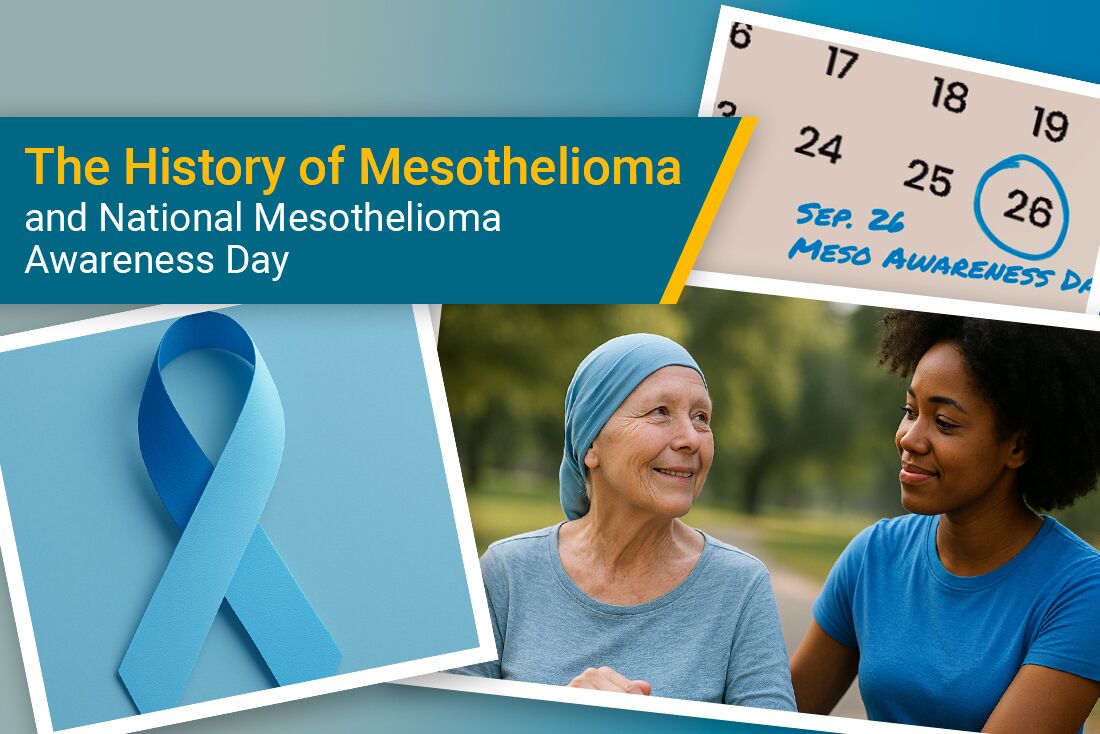Estimated Read Time: 3 minutes
Each year on September 26, people from all over the world join together to recognize National Mesothelioma Awareness Day. This day is dedicated to honoring patients, supporting families, and promoting progress in the fight against this rare cancer.
To understand why this day is so meaningful, let’s look back at the history of mesothelioma and how advocating for patients with this disease has grown into a powerful example of support, compassion and change.
The History of Mesothelioma
Mesothelioma is an aggressive cancer that develops in the lining of the lungs, abdomen, heart, or testes. The only cause of mesothelioma is exposure to asbestos, which is a mineral popularized in the 20th century in various industries and professions. Use of the mineral is now heavily regulated, and the most common type is banned in the United States.
While the disease is rare, the impact is devastating.
- In the early 20th century: Mesothelioma was first described in medical literature but was often misdiagnosed as other types of cancer.
- 1930-1950: Doctors and researchers were discovering a disturbing connection – workers exposed to asbestos were developing unusual lung conditions. Asbestos was widely used in insulation, construction materials, shipbuilding and manufacturing.
- 1960: Dr. Chris Wagner, a pathologist in South Africa, published research linking asbestos exposure directly to the development of mesothelioma. This discovery began to change the medical community’s understanding of this rare disease.
- 1970-1980: More cases of mesothelioma were being discovered in asbestos workers and military veterans – shining a light on the dangers of asbestos exposure. Regulations on the use of asbestos were introduced. Unfortunately, because of the long latency period (20–50 years), mesothelioma is diagnosed decades after exposure.
- Today: Asbestos use is restricted in many countries, but it is still not fully banned in the United States. The country recently banned chrysotile asbestos, which is the most common type of the mineral, a major step in progress. Researchers continue to investigate new treatment options, like immunotherapy and targeted therapies, to improve survival and quality of life for mesothelioma patients.
The History of National Mesothelioma Awareness Day
Mesothelioma is misunderstood, overlooked and often misdiagnosed. History shows that increased awareness and advanced research can change the future.
- 2004: Advocates for mesothelioma created the idea of a national day of recognition. Their goal was to give patients and families a way to bring more awareness to this devastating disease and the risks of asbestos exposure. September 26 was chosen as the official day of recognition.
- 2009-2010: The U.S. Senate and House of Representatives passed a resolution to designate September 26 as a national day of observation and awareness for mesothelioma. This was a huge step in bringing national attention to this rare cancer and the risks of asbestos exposure.
- Today: Mesothelioma Awareness Day is nationally recognized and has grown to a global observation. Every September 26, patients, survivors, caregivers, families, medical professionals, and advocates come together to:
- Wear blue to show their support
- Post on social media to educate others about the dangers of asbestos exposure and the impact of mesothelioma
- Contribute to research that could one day find a cure for mesothelioma
- Support stronger asbestos laws to protect the health of future generations
- Engage in community events supporting those impacted by mesothelioma
Why This Day Matters
Mesothelioma Awareness Day is more than a date on the calendar. It’s a chance to:
- Remember those we have lost
- Support the patients and caregivers currently fighting this rare cancer
- Promote research, advocacy and stronger asbestos safety regulations
As we honor the past and raise awareness today, we focus on a future with earlier detection, more effective treatments, and hope for a cure.
Sources & Author
About the Writer, Karen Ritter
Karen Ritter, a registered nurse, is the lead patient advocate for Mesothelioma Guide. She has a deep passion for patient care, which includes helping patients and their families search for treatment options at the top mesothelioma cancer centers. She finds the balance between encouraging patients to receive the best treatment possible while enjoying their time with loved ones and friends. Karen is a valuable asset for patients due to her knowledge of mesothelioma, compassion for the victims of this disease and dedication to guiding patients through their treatment journey.
